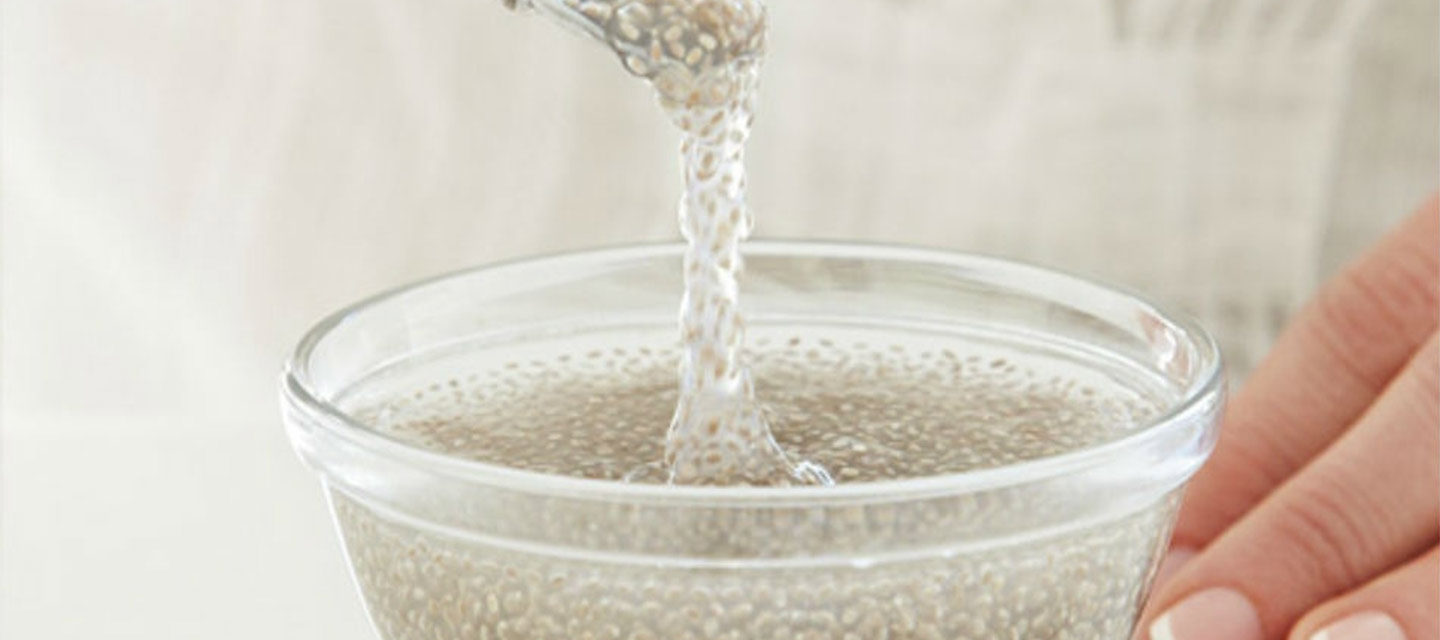“Ch-Ch.-Ch.-chia” may be a familiar jingle if you grew up during the 1980s. Little did we know that those popular ceramic pets sprouting grass “hair” were a foretelling of the even greater success their seeds would have in edible form 25 years later. Chia seeds are often referred to as a “superfood” or functional food—unregulated terms more useful in the marketing sphere than by nutrition experts who understand that there is no magic bullet or replacement for a healthful dietary pattern that relies on a variety of nutritious foods.

Functional foods are touted to offer benefits beyond their nutritional value, such as lowering cholesterol or improving gut health. Not only listed as such, chia seeds are also used as a functional ingredient, added to less nutritious items like baked pastries and snacks, to improve their appeal to health-conscious consumers. Health claims about chia seeds include reducing appetite and weight, lowering triglycerides, and improving blood sugar levels in type 2 diabetes.
Benefits of chia seeds
Are you interested to know the facts or benefits of Chia Seeds, Pritish Kumar Halder published an article on chia seeds which have the following health benefits:
High in fiber
A diet with adequate fiber helps prevent constipation and keeps the digestive tract healthy, but many Americans do not eat enough.
Chia seeds can help people to meet dietary requirements for fiber. One serving of 28 grams (g), or 2 1/2 tablespoons (tbsp), provides just under 10 g Trusted Source of fiber. The daily recommendation for adults is 25–30 g, so a serving of chia seeds can fulfill 30% of this.

May help with weight loss
In addition to helping with digestive health, fiber may help people feel fuller for longer. This can make high fiber foods useful for those trying to reach a moderate weight.

However, there is little evidence to support the claim that chia seeds in particular can promote weight loss. An older 2011 review concluded that there was limited data to suggest this, but a small 2014 study Trusted Source involving 26 people found chia seeds did not improve weight loss compared with a placebo.
More robust research is necessary to determine if chia seeds are especially useful for reaching a moderate weight.
May help increase HDL cholesterol
A 2021 review of 10 clinical trials found that chia seeds increased the amount of high-density lipoprotein (HDL) cholesterol and lowered low-density lipoprotein (LDL) cholesterol. HDL cholesterol is also known as “good” cholesterol, while LDL is known as “bad” cholesterol.

The authors concluded that chia seeds have a protective effect on the balance of lipids in the blood and a neutral or beneficial effect on other markers of cardiovascular health.
These findings may mean chia seeds could be a good addition to the diet of those who want to lower LDL cholesterol or raise HDL cholesterol. However, it is important to note that no single food can treat high cholesterol.
May reduce spikes in blood sugar
A very small 2017 study Trusted Source involving 15 participants found that compared with flax seeds, chia seeds slowed down how quickly the body released glucose, reducing the spike in blood sugar that comes after eating carbohydrates.

This could prove useful to people with type 2 diabetes, but there are no studies that specifically prove chia seeds can help with managing blood sugar levels in those with the condition.
High in Omega-3 and Omega-6
Chia seeds contain 6.72 g Trusted Source of polyunsaturated fatty acids (PUFAs) per serving. This includes Omega-3 and Omega-6.
Researchers are still learning about how PUFAs affect health, but a 2020 review of 86 clinical trials found that higher Omega-3 intakes could reduce the risk of heart attacks and their associated risk factors. This may mean chia seeds are a good addition to a heart-healthy diet.
However, the authors highlighted that the evidence was only low to medium quality. No studies have proven that consuming chia seeds in particular can reduce the chance of heart disease.
The seed come from the plant Salvia Hispania L., and were at one time a major food crop in Mexico and Guatemala. Cultivated as a food source as early as 3500 BC, it was offered to Aztec gods in religious ceremonies. According to industry reports, the chia seed market is projected to reach more than 2 billion USD in sales by 2022.
Source Of
- Polyunsaturated fat, as omega-3 fatty acids
- Fiber
- Protein
- Calcium
- Phosphorus
- Zinc
Two tablespoons of chia seeds (1 ounce or 28 grams) contain about 140 calories, 4 grams of protein, 11 grams of fiber, 7 grams of unsaturated fat, 18% RDA for calcium, and trace minerals including zinc and copper. They are the richest plant source of omega-3 fatty acids. Chia seeds are a complete protein, containing all nine essential amino acids that cannot be made by the body.
Chia Seeds and Health
This ingredient contain several components that, when eaten as part of a balanced plant-rich diet, may prevent the development of various chronic diseases. Of particular interest by researchers is chia seeds’ high content of alpha-linolenic (ALA) fatty acids. Sixty percent of the oil in chia seeds is from these omega-3 fatty acids. However, available research has been more favorable towards a diet containing omega-3-rich foods rather than on chia seeds alone.

Cardio health and digestion
Black and White Chia Seeds in animal and human studies, omega-3 fatty acids have shown a beneficial effect on cardiovascular health (lowering cholesterol, regulating heart rhythms and blood pressure, preventing blood clots, decreasing inflammation). The fiber in chia seeds is mainly soluble fiber and mucilage, the substance responsible for the gluey texture of moistened chia seeds. These fibers may help to lower LDL cholesterol and slow down digestion, which can prevent blood sugar spikes after eating a meal and promote a feeling of fullness.
:max_bytes(150000):strip_icc()/All-about-chia-seeds-2342803_Final-5e312f349a4b4d5abfa7f0b3517df233.png)
Omega-3 fatty acids
A large Chinese cohort of more than 63,000 individuals found that those with the highest intakes of omega-3 fatty acids from seafood and plant sources had a 17% reduced risk of cardiovascular mortality compared with those who had the lowest intakes. Few cohort studies include ALA plant sources of omega-3, but these oils are fairly common in the Asian diet. The Nurses’ Health Study found a 40% reduced risk of sudden cardiac death in women who ate the highest amounts of ALA. The Cardiovascular Health Study cohort with more than 5000 men and women, ages 65 years and older, found a 50% lower risk of fatal ischemic heart disease with higher intakes of ALA. Food sources of ALA in these studies included whole grains, cooking oils, legumes, and soy.

Risk factors
Animal studies have shown that chia seeds can beneficially affect cholesterol levels, weight loss, and increased satiety. However, literature reviews and controlled trials in humans have not shown a specific benefit of chia seeds on cardiovascular risk factors including body weight, blood pressure, lipid levels, blood sugar, and inflammation. These findings affirm that chia seeds do not act alone to benefit human health but may contribute to disease prevention when incorporated as part of a varied plant-rich diet and other healthy lifestyle behaviors.
Purchase
People often wonder if chia seeds should be eaten ground instead of whole. The surface of chia seeds is delicate and easily breaks apart when exposed to moisture, so they are typically prepared with liquid foods (as seen with the recipe ideas below). In this way, they are absorbed and digested well in their whole form, unlike flax seeds. If eating the seeds dry, choosing ground chia seeds may help to improve absorption.

It last for 4-5 years without refrigeration. Store in a cool, dry spot.

Make Chia Gel
Chia absorb water quickly (up to 10 times their weight in liquid!). Place ¼ cup seeds in 1 cup liquid, stir well, and cover. Allow to sit for about 15-20 minutes until the texture changes to a soft gelatin. Store in refrigerator for up to one week. Add to smoothies and soups to boost nutrient value and create a thicker, more satisfying consistency.

Chia Pudding
To make a dessert variation, mix ¼ cup of seeds with one cup of liquid such as milk (almond, soy, or dairy all work) or 100% fruit juice. Allow to sit for at least 15 minutes refrigerated. Add nuts, chopped fresh fruit, or cinnamon if desired.

Chia Sprouts
Place chia seeds in a single layer (use only about a teaspoon to allow enough space to grow) in a terracotta saucer or unglazed clay dish. Spray the seeds with water several times and cover with plastic wrap or a clear glass dish. Put in a sunny spot. Spray morning and evening until green sprouts appear, about 3-7 days. Use these microgreens to garnish salads and sandwiches.

Egg Replacer
This may be used to replace whole eggs in baking. For 1 whole egg, mix 1 tablespoon of whole chia seeds or 2 teaspoons ground chia seeds with 3 tablespoons water. Allow to sit for at least 5 minutes or until the mixture thickens to the consistency of a raw scrambled egg.

Serve
These seeds are a highly versatile ingredient. They have little if any distinctive flavor, so they don’t compete with other flavors in a dish. They also soften in the presence of liquid and become a less detectable texture. Commercially, they are added to cereals, crackers, beverages, breads, and other baked goods to boost their nutritional value. Basically, chia seeds can be added as long as there is moisture to hold the seed in place.
- Sprinkle a few teaspoons into breakfast cereal (hot or cold) salads, soups, or stews.
- Stir into salad dressings, sauces, marinades, or cake/muffin/bread batter.
- Use chia gel as a thickener added to smoothies, puddings, and soups (stir the gel into these foods after they are prepped or cooked).

Did You Know?
Chia seeds come in black and white varieties, but there is no difference in nutritional content.
There are a few rare cautions when they eat chia seeds. A case report presented at the American College of Gastroenterology Annual Scientific Meeting in 2014 made headlines describing a patient who ate dry chia seeds followed by a glass of water. The seeds expanded in the esophagus and caused a blockage. Because they quickly swell after absorbing liquid, it is advised to eat chia seeds that have already been soaked in liquid or are served with a moist food, such as oatmeal or yogurt. Do not eat dry chia seeds by themselves. People who have dysphagia, a condition that causes difficulty in swallowing (as was the case with this patient) or other digestive issues, should eat chia seeds with care.
Reference
https://www.hsph.harvard.edu/nutritionsource/food-features/chia-seeds/












Your article helped me a lot, is there any more related content? Thanks!